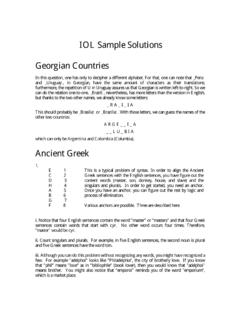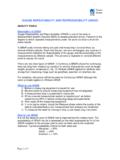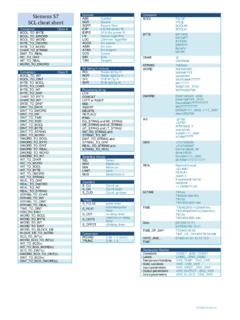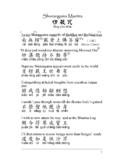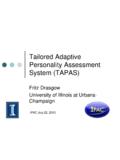Transcription of 7KHUH DUH QDPHV RI VRPH FRXQWULHV LQ …
1 Georgian Countries There are names of some countries in South America, written in the Georgian language, together with their translations to English: What are the names, in English, of the two untranslated countries? Problem by Bruno L Astorina for the Brazilian Linguistics Olympiad 2016 Ancient Greek Consider these phrases in Ancient Greek (in a Roman-based transcription) and their unordered English translations: (A) ho t n hyi n dulos (1) the donkey of the master (B) hoi t n dul n cyrioi (2) the brothers of the merchant (C) hoi tu emporu adelphoi (3) the merchants of the donkeys (D) hoi t n on n emporoi (4) the sons of the masters (E) ho tu cyriu onos (5) the slave of the sons (F) ho tu oicu cyrios (6) the masters of the slaves (G) ho t n adelph n oicos (7) the house of the brothers (H) hoi t n cyri n hyioi (8) the master of the house 1. Match the Ancient Greek phrase (A-H) with the corresponding English translation (1-8).
2 2. Translate into Ancient Greek: a) the houses of the merchants b) the donkeys of the slave. Note: the letter stands for a long o. Problem by Todor Tchervenkov for the North American Computational Linguistics Olympiad 2007 Aragonese In the Iberian Peninsule, there are several languages, apart from Portuguese and Spanish (Castillan), that share the same romanic origin, such as Catalan, Galician, Mirandese, Asturian, Leonese and Aragonese. The list below brings a list of words in Aragonese, their plural forms and their translations to . Seguem algumas palavras em aragon s com suas tradu es para o portugu s e suas formas no plural: valley bal bals stool banquet banquetz hole clot clotz stone cantal cantals awake concordau _____ chocolate chicolat _____ union chunta _____ unhanded deixau deixaus eclipse eclix _____ cicada ferfet _____ character personache personaches fish peix peixes Write down the missing words.
3 Problem by Bruno L Astorina for the Brazilian Linguistics Olympiad 2016 Japanese Braille Braille is a tactile writing system, based on a series of raised dots, that is widely used by the blind. It was invented in 1821 by Louis Braille to write French, but has since been adapted to many other languages. English, which uses the Roman alphabet just as French does, required very little adaptation, but languages that do not use the Roman alphabet, such as Japanese, Korean, or Chinese, are often organized in a very different manner! To the right is a Japanese word written in the tenji ( dot characters ) writing system. The large dots represent the raised bumps; the tiny dots represent empty positions. karaoke 1. The following tenji words represent atari, haiku, katana, kimono, koi, and sake . Which is which? You don t need to know either Japanese or Braille to figure it out; you ll find that the system is highly logical.
4 A. b. c. d. e. f. 2. What are the following words? g. h. 3. Write the following words in tenji characters: i. samurai j. miso Problem by Patrick Littell for the North American Computational Linguistics Olympiad 2009 Lalana Chinantec Lalana Chinantec is a language spoken by approximately 10,000 people who live in the Oaxaca region of Mexico. In the following orthography a colon (:) marks a long vowel, and the symbol marks a glottal stop (like the sound in the middle of uh-oh). kalakwa: kw : li: The beautiful corn grew. m la mo:h kya My pineapples have turned out well. li: kalane kw : kwa: kya My tall corn yellowed beautifully. kalaro:h mo:h ne kya My yellow pineapples ripened well. kala kw : The corn turned out well. m lakwa: kw : The corn has grown. 1. What does the word li: mean? 2. What does the word ro:h mean? 3. Translate the following sentences into Lalana Chinantec: a) The good pineapples became beautiful.
5 B) My ripe corn has yellowed well. 4. Translate the following sentences into English: c) m laro:h kw : ne d) li: kalakwa: kw : Problem by Rachel Nordlinger for the Australian Computational and Linguistics Olympiad 2008 Data from Merrifield, W. et al (2003). Laboratory Manual for Morphology and Syntax, 7th edition. Dallas: SIL International. Molistic Imagine that you have heard these sentences: Jane is molistic and slatty. Jennifer is cluvious and brastic. Molly and Kyle are slatty but danty. The teacher is danty and cloovy. Mary is blitty but cloovy. Jeremiah is not only sloshful but also weasy. Even though frumsy, Jim is sloshful. Strungy and struffy, Diane was a pleasure to watch. Easy though weasy, John is strungy. Carla is blitty but struffy. The salespeople were cluvious and not slatty. 1. Then which of the following would you be likely to hear? a. Meredith is blitty and brastic. b. The singer was not only molistic but also cluvious.
6 C. May found a dog that was danty but sloshful. 2. What quality or qualities would you be looking for in a person? a. blitty b. weasy c. sloshful d. frumsy Problem by Dragomir Radev for the North American Computational Linguistics Olympiad 2007 Persian Several Persian phrases are presented together with their translations: gorbe zir-e raxtex b the cat under the bed x ne p in-e kuh the house under the mountain ah rp ye zir-e miz the stool under the table ye zir-e pol the boat under the bridge am nat p in-e dar the package under the door ahr zir-e ft b the city under the sun n me zir-e ket b the letter under the book ket b p in-e komod the book on the lowest shelf in the bookcase 1. Translate into English: a) ah rp ye p in-e miz _____ b) ket b zir-e komod _____ 2. Here are two English phrases and their Persian translations (with gaps): c) the stone under the water sang _____ b d) the box under the tree ja'abe _____ deraxt Fill the gaps.
7 If you think that some of them can be filled in more than one way, give all possible answers. Explain your solution. Note: , , , , , ' represent specific Persian sounds. Problem by Yulia Mazurova for the Moscow Traditional Olympiad of Linguistics 2001/2002 Kazakh Several phrases have been translated into Kazakh (written in Roman script here), but the translations are given in random order. Some of the words are missing. a. one and five i. ____ ben el w b. one and eight ii. bir men bes c. three and two iii. bir _ segiz d. four and seven iv. el w eki men on e. seven and fifty v. ____ men el w f. eight and fifty vi. ot z ben ____ g. thirteen and thirty vii. t rt pen eti h. thirty and two viii. ____ eki i. fifty-two and ten ix. on pen ot z 1. Match each phrase with its correct translation and supply the missing words. 2. Translate into Kazakh: a. five and thirty-eight b.
8 Ten and four c. seven and fifty-three d. thirty-eight and five Note: i, , , are specific Kazakh vowels. The letter has the sound of s in the word usual. ! Kazakh language belongs to the Central Turkic groups of languages. It is the official language and principle native language of the Republic of Kazakhstan. It is spoken by about 6,5 million people in Kazakhstan and about 1,5 million people southern Siberia, northwestern China and northwestern Mongolia. Problem by Pyotr Zubkov for the Moscow Traditional Olympiad of Linguistics 2002/2003 Taikyoku Sh gi Japanese Chess (Sh gi), played on a board of size 9 by 9 and with a total of 40 men, is the most popular intellectual game in contemporary Japan, where it entertains between 10 and 20 million people. But between the 8th and 18th century many other variants of the game were invented in that country, some on smaller and some on larger boards. The largest of all Japanese chess games (and generally the largest chess game in history) is Taikyoku Sh gi (more or less Ultimate Chess ), in which the board is of size 36 by 36 (or 1296 squares in all) and every player has in the beginning an army of 402 men of 208 different types.
9 This is a table which contains the names of some of the men in Taikyoku Sh gi (in Japanese and in English translation), as well as the name of the man to which each of them promotes upon reaching one of the farthest 11 ranks of the board. Initial value Promoted value 1. Running Stag honroku 2. t sh Sword General 3. gy hei Ox Soldier 4. Right General ugun 5. Ox General hongy 6. ky hei Bow Soldier Bow General 7. kisho Wood General 8. dohei Crossbow Soldier 9. Dashing Horse 10. Left Chariot 11. Horse Soldier s ba 12. s y Running Bear Dashing Bear 13. tonsh Pig General honton 14. tessh hakuz White Elephant 15. sagun Left Army 16. usha utessha Right Iron Chariot 17. honr Dashing Wolf 18. sekish Stone General White Elephant Fill the gaps. Note: A bar above a vowel letter indicates length.
10 Problem by Ivan Derzhanski for the Moscow Traditional Olympiad of Linguistics 2002/2003 Tup and Guaran The Tupi-Guarani language family, widespread in the lowlands of South America, was very important in the history of the colonization of the continent. Among them, the most famous languages are Tupinamb (old Tupi), spoken along the Portuguese coast in the colonial times, and Guarani, still spoken today in southern Brazil, Argentina, Uruguay and Paraguay (being co-official in the later). The table below shows some words in Tupinamb , their translations to English and their correspondents in Guaran Mbya, one of the forms of the Guaran language. English Tupinamb Guaran Mbya English Tupinamb Guaran Mbya rock it it to beat petek soil yb yv to hear senub water y y red pyranga black un lizard teju head akanga ak I say a to bring erur eru beautiful porang to hear endub endu mouth juru to experiment sa ang ha half ku a you want erepot r erepot wood yvyr to heal puer b kuer you stay erepyt I sleep aker ak high yvat boss ubixab erek rib arukang jaguar to overcome opuan pot peanut mandubi 1.
